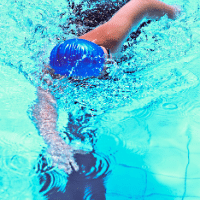
Swimmer’s Ear
Do you think your ear is itching? If so, you could have a case of swimmer’s ear. Untreated, the infection can spread to nearby tissue and bone. Swimmer’s ear symptoms are usually mild at first, but they can worsen if your infection isn’t treated or spreads. Redness of the ear canal, draining fluids and discharge of pus are all signs that something might be wrong.
Swimmer’s ear is an uncomfortable, painful infection that can be difficult to treat. Swimmers ear, also known as otitis externa, is an infection that can be caused by bacteria invading the skin inside your ear canal. Otitis externa is a condition that can cause the outer ear canal to become red and swollen. It’s often called “swimmer’s ear” because repeated exposure to water makes it more vulnerable to inflammation (edema). This typically results from a person swimming in water with too high of a concentration of chlorine or salt water. Prompt treatment can help prevent complications and more-serious infections.
The best way to avoid getting swimmer’s ear is by taking precautions after swimming or bathing in water. There are a lot of different products on the market that claim they can prevent swimmer’s ear, but most don’t actually work.
Cooling off in the summertime means getting your wet feet and shirt out of a puddle, but it also can lead to ear infections. Bathing can be therapeutic but watch out for your ears – getting water in it for long periods of time may cause swimmer’s ear. A child is also very prone to get swimmer’s ear so take extra precaution and be alert for any sign of infection. The reason is that moisture from these sources can get inside your ears and irritate them.
Keeping our fingers, cotton swabs or other objects in our ears for an extended period of time is not only bad for hearing, but it may also result in swimmer’s ear if the skin lining the ear canal becomes damaged by water exposure.
Swimmers Ears Symptoms
Swimmers often refer to this condition as “swimmer’s ear” due to its prevalence when water is trapped inside their ears for too long during prolonged periods underwater while swimming (or getting caught in waves). The most common symptom is itching around the outer part of your ear canal accompanied by redness and discomfort when you try to touch it.
Suffering from swimmer’s ear? No worries. A swimming related infection can be treated and cured with some antibiotics, anti-inflammatory medication, or topical creams. Milder symptoms include itchiness in the ears and painful drainage out of the ears. Moderate symptoms include a rash around the outer layer of your ear canal that may form scabs on it. Advanced stages are more severe than moderate yet not as bad as severe–these signs include pus draining out of your ear canal, an extreme amount of pain, or a high fever due to complications from infection such as cellulitis or sepsis.
Swimmer’s Ear: When to see a doctor?
The swimmer’s ear is a common and often recurring condition for those that make the majority of their living in or near water. Contacting your doctor immediately if you have even mild signs or symptoms can prevent this from becoming more severe and potentially worsening into other illnesses. If you are not sure, it’s best to visit the emergency room where they can properly diagnose your condition.
Swimmer’s Ear: Causes
Swimmer’s ear is an infection that can be caused by bacteria, fungi or viruses. It’s less common for a fungus or virus to cause swimmer’s ear. Your outer ear canals have natural defenses that help keep them clean and prevent infections. If you happen to have or experience symptoms of swimmer’s ear, your natural defenses have most likely been overwhelmed.
Conditions that can weaken the natural defenses of your ears and promote bacterial growth include:
Excess moisture in your ear – Perspiration, prolonged humid weather or water that remains in your ear after swimming can create a favorable environment for bacteria.
Scratches or abrasions in your ear canal – The skin inside your ear is delicate and can easily break down. This can happen when you clean your ears with cotton swabs, scratch them with a finger, or wear hearing aids too often. These can cause small breaks in the skin which allow bacteria to grow.
Sensitivity reactions/allergy – Some hair products or fashion jewelry may cause skin conditions or allergies that can promote infection. If you know for a fact that you are prone to allergies, better be careful of your product choices.
Swimmer’s Ear Risk Factors
Factors that can make you more at risk in getting swimmer’s ear include:
- Ear infections
- Excessive ear wax buildup
- Swimming in dirty water or saltwater
- A ruptured eardrum
Swimmer’s Ear Complications
In most cases, swimmer’s ear isn’t really considered as a serious condition, but, if left untreated for a long period of time, complications may occur. Below are some swimmer’s ear complications to look out for:
Temporary hearing loss. You may experience muffled hearing which eventually gets better when the infection clears up.
Long-term infection (chronic otitis externa). There’s something about these stubborn infections that makes them difficult to treat- they tend to persist for more than three months and have signs and symptoms like a bacterial or fungal infection, an allergic reaction to antibiotic eardrops, psoriasis, dermatitis or some other skin condition. Knowing what to do if you suspect you might have this type of infection can help keep it under control.
Deep tissue infection (cellulitis). In rare cases, swimmer’s ear can seep into the deep layers and connective tissues of the skin, causing cellulitis.
Bone and cartilage damage (early skull base osteomyelitis) This is a rare complication that occurs when swimmer’s ear spreads to the cartilage of the outer ear and bones in the lower part of your skull, causing severe pain. Older adults are at increased risk for this complication due to weaker immune systems.
Swimmer’s Ear Prevention
Keep your ears dry. Dry your ears thoroughly after bathing or swimming. Dry the outer ear by wiping it slowly and gently with a soft towel. Dip your head to the side to help water drain from the ear canal. If you have an electric blow dryer on hand, use it on its lowest setting – but make sure to maintain at least one foot away from your ear to avoid burns.
Avoid putting foreign objects in your ear. Having an itchy ear is an uncomfortable feeling that can be hard to ignore. But, we discourage using cotton swabs, paper clips or hairpins in an attempt to scratch the itch. These items are not only ineffective at scratching the itch but they also have the potential to irritate your ear canal and break through your skin.
Swimmer’s Ear – Diagnosis, Treatment, Therapy
For most cases of swimmer’s ear, doctors will usually prescribe eardrops that have some combination of the following ingredients, depending on the seriousness and type of infection: Acidic solution to help bring back the ear’s normal antibacterial environment. Steroid to reduce inflammation or edema. Antibiotic to fight bacteria.
If you or someone in your family is suffering from swimmer’s ear, don’t hesitate to seek medical attention – it’s wiser than relying on home or DIY treatments. If you’re in the Osseo, MN area and would like to see an audiologist to check on your swimmer’s ear, come visit us at Hearing Health Clinic.

